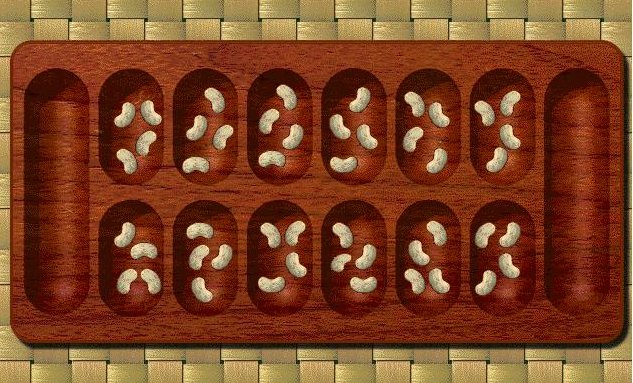
by John P. Pratt
Wed 9 Sep 2009
Mancala is the name given to a whole series of games which come from Africa and have been played for over 4,000 years. They have rules simple enough for children to learn, but can challenge adults with the depth of the logic and foresight needed to play well. To me they are so fun that I've decided to add this page to my website. I once tried to write a computer program to play it, but soon learned I don't really know how to play to win consistently myself, much less teach a computer. I'm currently playing an eight-year-old who plays even with me. There are many similar web pages that list variations, but many do not have the simple focus of actually learning how to play these great games. Many do not include enough information to really play, and many have mistakes (please tell me if I do also!). There are hundreds of variations, and I've tried to pick out a few that are clearly related and are the most fun to play.
 |
The most typical Mancala board consists of a wooden board with two rows of six indented "pits", each with an associated larger "capture pit" at the end of the board. The number of rows and pits can vary, but this arrangement is the most common, and the one sold in many other countries. All of the games outlined here use this board, which is placed between the players, so that each has a row of six pits in front of him.
"Seeds" are placed in each of the pits to begin a game, as in the illustration. Many games begin with four seeds in each pit. Any object can be used other than seeds, but ideally the objects should be about the same size and small enough for 15 to be placed into each pit. They can be stones, marbles, ball bearings, or anything similar. Unfortunately, most of the commercial versions come with large stones, such that only about 8 can easily fit into each pit. That makes it difficult because part of the game is to be able to choose your moving by counting the stones in a pit without touching (or even pointing to them). I recommend pinto beans to be used as the seeds, as in the illustration. Moreover, you are probably going to want to put six seeds in each pit, and most commercial versions only come with four stones per pit.
In all of the games described, the six pits nearest to you are considered yours, and the other six belong to your opponent. The capture pit to the right of your six pits is also yours, and will be used to store captured seeds. The other capture pit belongs to your opponent.
The order of play is determined by one player hiding a seed in one hand and the other player choosing which hand has the seed. If he successfully chooses the hand, he moves first, which sometimes is an advantage.
Moves are made by removing all of the seeds from one of your six pits (that is not empty), and "sowing" them counterclockwise around the board, beginning with the first pit to the right of the pit being played (if there is one). The direction of play is extremely important because once the game is learned, it is really hard to mentally change the direction, so ignore any instruction sheets that say otherwise. Sometimes seeds are placed into your capture pit and sometimes not, depending on the game being played. In all cases, however, the seeds are sown in a circular fashion, being dropped into the opponents pits if there are sufficient, then always skipping his capture pit, and continuing back to your own side. Examples are given in each of the game descriptions to make this clear. No seeds are ever played from the capture pit; once there, they stay there for the remainder of the game. In all of the versions described here, the object of the game is to get more seeds in your capture pit than your opponent gets in his. Also, in all versions, the game ends when one player cannot move, usually because all six of his pits are empty and it is his turn.
Usually there is a rule that seeds can only be counted by looking at them. It is illegal to touch them, or even to point to them while counting. When a seed is touched, then that pit must be played.
The rules given in most commercial versions correspond to what is herein called "Egyptian Mancala", usually shortened to simply "Mancala". It is perhaps the most fun game and can be played well enough by a six year old to beat his parents. It is a great confidence builder for them, as well as teaching them logic and looking ahead for both offense and defense. So here are the various games.
Mancala
Four variations of Mancala: Basic, Egyptian, Ethiopian and Random.
Wari
Wari is probably the most played in Africa.
Ayoayo
A form of multi-lap Mancala.
Giuthi
This is a great game, but it more difficult and suitable for those familiar with the simpler rules.